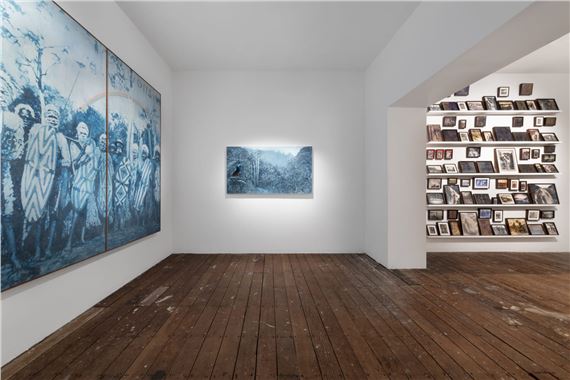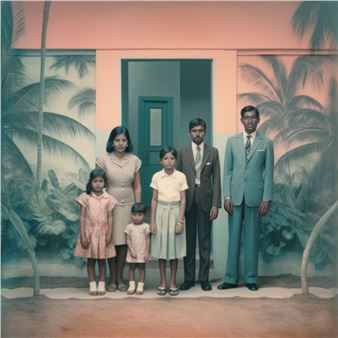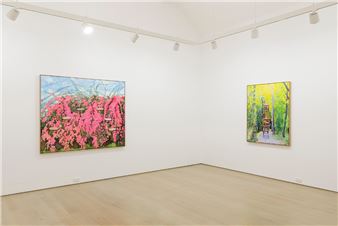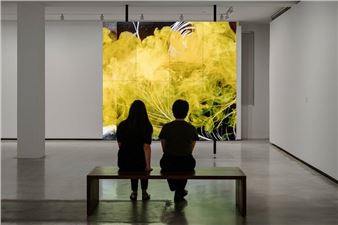Danie Mellor: Dirran: At the Edge of the Forest
dirran: at the edge of the forest is an exhibition of new and recent works exploring landscape and history, memory and relationship. Through painting, photography, and moving image, Danie Mellor reimagines historical records and their visible remnants, blending archival and contemporary sources as recomposed and captivating, often haunting scenes.
ÔÇÿdirranÔÇÖ translates as ÔÇÿforest edgeÔÇÖ in the Dyirbal language of MellorÔÇÖs matrilineal ancestors and for him suggests a space of environmental difference and change, a subliminal threshold evoking magical possibility.
Central to MellorÔÇÖs practice is landscape and CountryÔÇöand its documentationÔÇöat the intersection of history, experience, and understanding. His imagery embraces multifaceted understandings of land and place, where contrasting narratives coexist alongside spiritual dimensions, ancestral influences, and enduring Aboriginal connections to place. It envisions a convergence of past, present, and future, acknowledging our shared experience in evolving cultural landscapes.
MellorÔÇÖs works offer a space of remembrance and dialogue between painted and photographic imagesÔÇöa construction and disclosure that, as Susan Sontag once observed, is inherent to both mediums. In his recompositions of colonial-era imagery that evoke a deliberate nostalgia, Danie reassigns agency, restoring connections to land and ancestors.
Archival photography has indelibly shaped MellorÔÇÖs relationship with imagery. A rich family collection, including carte-de-visite portraits of several generations of his maternal Aboriginal grandmothers taken in the photographer Alfred AtkinsonÔÇÖs Cairns studio, has inspired sustained research into the lasting impact of images. Repurposing works by late-19th-century anthropologists and photographers such as Atkinson, he creates compositions that evoke real yet imagined spaces. In his paintings and imagery, Danie recreates these archaeological layers of history, the resulting mises-en-sc├¿ne appearing as authentic reproductions that challenge our readings of historical photographs, and the interactions between people depicted in the work.
Drawing from personal and wider histories, Mellor crafts nuanced narratives amid tragedy and disruption. His detailed works focus on intimate human interactions, exploring emotional undercurrents in unseen encounters between individuals, their relationships, and surrounding landscapes. By offering ambiguity in the work, he prompts viewers to draw on their own memories, reshaping understandings of history.
Mellor seeks to reveal the invisible essence of the landscape, capturing visceral responses to primordial rainforests that stir profound inner awakenings. To make the hidden visible, he uses infrared photography, the detection of invisible light symbolically, or perhaps materially, unveiling spaces of memory, spirit, and Dreaming. His approach documents ancestral presence and ancient histories, evidence of prior existence and continuous life in an otherwise concealed realm of knowledge and phenomena.
Dark Star Waterfall, a significant new video work and MellorÔÇÖs first in this medium, reflects on elemental forces and vast rainforest expanses. The ÔÇÿdark starÔÇÖ, an early astronomical term for black holes, provides a symbolic connection through the irresistible pull towards waterfalls and the ÔÇÿfallÔÇÖ of water. The precipice and edge of a waterfall is for water what the event horizon of a dark star is to light and matter: at a certain point inescapable. Waterfalls located in traditional Ngadjon and Mamu Country on the Atherton Tablelands were filmed using infrared and visible light cameras, the moving imagery extending MellorÔÇÖs use of still photographs as a symbolic means of disclosure and revelation.
Several audio sequences in the film are based on sonifications of astronomical data (including infrared light) converted into audible tones of Sgr A* (Sagittarius A*), the supermassive black hole at the centre of our Milky Way. This reference to astronomical data reinforces the connection of ÔÇÿlocalÔÇÖ cosmology to the video and the Milky Way as a place of origin and habitat of the rainbow serpent, emphasising the significance of Yamani and its centrality in Aboriginal rainforest legends of landscape and creation.

Recommended for you
dirran: at the edge of the forest is an exhibition of new and recent works exploring landscape and history, memory and relationship. Through painting, photography, and moving image, Danie Mellor reimagines historical records and their visible remnants, blending archival and contemporary sources as recomposed and captivating, often haunting scenes.
ÔÇÿdirranÔÇÖ translates as ÔÇÿforest edgeÔÇÖ in the Dyirbal language of MellorÔÇÖs matrilineal ancestors and for him suggests a space of environmental difference and change, a subliminal threshold evoking magical possibility.
Central to MellorÔÇÖs practice is landscape and CountryÔÇöand its documentationÔÇöat the intersection of history, experience, and understanding. His imagery embraces multifaceted understandings of land and place, where contrasting narratives coexist alongside spiritual dimensions, ancestral influences, and enduring Aboriginal connections to place. It envisions a convergence of past, present, and future, acknowledging our shared experience in evolving cultural landscapes.
MellorÔÇÖs works offer a space of remembrance and dialogue between painted and photographic imagesÔÇöa construction and disclosure that, as Susan Sontag once observed, is inherent to both mediums. In his recompositions of colonial-era imagery that evoke a deliberate nostalgia, Danie reassigns agency, restoring connections to land and ancestors.
Archival photography has indelibly shaped MellorÔÇÖs relationship with imagery. A rich family collection, including carte-de-visite portraits of several generations of his maternal Aboriginal grandmothers taken in the photographer Alfred AtkinsonÔÇÖs Cairns studio, has inspired sustained research into the lasting impact of images. Repurposing works by late-19th-century anthropologists and photographers such as Atkinson, he creates compositions that evoke real yet imagined spaces. In his paintings and imagery, Danie recreates these archaeological layers of history, the resulting mises-en-sc├¿ne appearing as authentic reproductions that challenge our readings of historical photographs, and the interactions between people depicted in the work.
Drawing from personal and wider histories, Mellor crafts nuanced narratives amid tragedy and disruption. His detailed works focus on intimate human interactions, exploring emotional undercurrents in unseen encounters between individuals, their relationships, and surrounding landscapes. By offering ambiguity in the work, he prompts viewers to draw on their own memories, reshaping understandings of history.
Mellor seeks to reveal the invisible essence of the landscape, capturing visceral responses to primordial rainforests that stir profound inner awakenings. To make the hidden visible, he uses infrared photography, the detection of invisible light symbolically, or perhaps materially, unveiling spaces of memory, spirit, and Dreaming. His approach documents ancestral presence and ancient histories, evidence of prior existence and continuous life in an otherwise concealed realm of knowledge and phenomena.
Dark Star Waterfall, a significant new video work and MellorÔÇÖs first in this medium, reflects on elemental forces and vast rainforest expanses. The ÔÇÿdark starÔÇÖ, an early astronomical term for black holes, provides a symbolic connection through the irresistible pull towards waterfalls and the ÔÇÿfallÔÇÖ of water. The precipice and edge of a waterfall is for water what the event horizon of a dark star is to light and matter: at a certain point inescapable. Waterfalls located in traditional Ngadjon and Mamu Country on the Atherton Tablelands were filmed using infrared and visible light cameras, the moving imagery extending MellorÔÇÖs use of still photographs as a symbolic means of disclosure and revelation.
Several audio sequences in the film are based on sonifications of astronomical data (including infrared light) converted into audible tones of Sgr A* (Sagittarius A*), the supermassive black hole at the centre of our Milky Way. This reference to astronomical data reinforces the connection of ÔÇÿlocalÔÇÖ cosmology to the video and the Milky Way as a place of origin and habitat of the rainbow serpent, emphasising the significance of Yamani and its centrality in Aboriginal rainforest legends of landscape and creation.

 ARTISTS
ARTISTS













